This entry is a lengthy account of the research I have done in the lead up to the current MA dissertation. Here are notes from exhibitions and galleries I have visited, talks and courses, and projects I have been involved in. As well as that, I have worked on several opportunities to show my work which is a form of action research, especially in terms of my site-specific process, based on being in a place, observing and letting the ideas come.
So it will be a useful distillation of key learning points for future reference, supporting the writing of my dissertation, and grounding my developing practice. The long list below includes more recent research activity but several past blog entries serve a similar purpose, and should also be considered as part of my hand-in for Research Methods 2.
I take extensive ‘raw’ notes in a series of notebooks which will also be submitted with the blog. There is a lot of detail there which backs up and augments the summary information here. I also intend to go back through all of the blog entries, adding tags to help reading and retrieval of information. This, together with an extensive picture library, is the core reference material supporting my practice, on an ongoing basis. The website has provided an useful framework for this.
Nathalie Holbrook show- Land and Tide
At the An Talla Solais (Hall of Light in Gaelic) gallery in Ullapool in May. The work was beautiful and I learnt a lot from the artist’s talk she gave one evening. She described her dissatisfaction from the competitive and individualistic atmosphere of her BA in Photography course at Glasgow School of Art, preferring her experiences in Canada and Hawaii where she organised placement visits and was able to work in a much more cooperative and grounded way with other artists and indigenous people. Her work is based on being ‘in place’, gathering and recording. She uses found objects and stories, exhibited here as large-scale assemblages, collages, multiples, drawings, beautifully curated in the attractive and accessible high street gallery space.



Key things- the value of collaboration, step back and take time to let the place, people and things of the place (which she ‘gathers’) speak and tell their stories (quote from her website “No entity on this Earth is without a home or story. One must simply look, and listen. Notice the encounter and the stories that are woven with the threads and bark of Life.”). I also wrote in my notes from the talk that she aims to let the thing reveal its story then invite audiences to rediscover it and then, perhaps, look in a new way for the stories held in place. She had an eye for history and was unafraid of showing what she felt about injustice and cruelty, to both people and the environment (revealing traces of the Highland Clearances and recording the destructive impact of human activity). Her work was great- beautiful, restrained, respectful of the stuff of place. I aspire to create work as lovely and meaningful as hers. Pleased to see a young woman as determined, talented, and creative as she is, whilst remaining open about her process, its difficulties and her doubts.
I value personal generosity in general, openness and honesty, being brave enough to show vulnerability. So I am grateful when artists present themselves and tell the story of their work, especially when it becomes a driving principle in their art- Alec Finlay, Jo Spence, Jaume Plensa come to mind.
Carla Moss and the Other Art Fair
I met another woman artist by happy chance through Leeds Creative Timebank. Carla and I have interests in common and have continued to meet regularly, sharing ideas and insights and pointing each other in the direction of artists and writers who we find inspiring. I am grateful to Carla for her knowledge and ideas, especially for introducing me to Bracha Ettinger. She also helped me get to know more about East Street Arts (she is based there) and I helped her to get her work down to the Other Art Fair in Shoreditch.
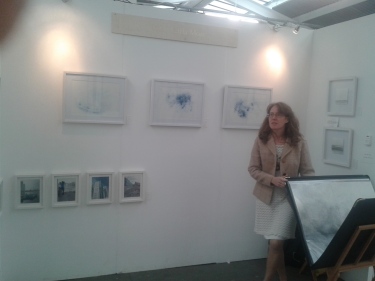
Carla’s stand at the Other Art Fair


Some of her work
Carla’s work articulates her interest in, and concern about, our relationship with the environment, time and place. She works across media, including performance and travelling, again it concerns experience of place, and gathering and recording stories and things. I particularly like her skilfully drawn, carefully restrained pieces, and the gentle power with which they make their point.
Both Nathalie and Carla also include conversations and encounters with people as part of their place-based practice.
Carla and I have a mutually beneficial relationship which keeps throwing up ideas and opportunities which I am looking forward to developing further.
I also include below a series of images from the Other Art Fair, of work which stood out for me, and from which I am drawing in my practice.
Key things:
- Drawn to subdued or monochrome work
- Natural world, place, found materials
- Multiples
- Collage and transformation of material
And more….. all in photos stored on my hard drive- need to spend a day or three reviewing and filing images, sorting out the learning, and marking out things I want to work on.

Found natural materials beautifully presented- link to place.

Landscape on corrugated cardboard

Mixed media- like the use of newsprint

Flying books

Torn drawing presented as multiples- Khadi paper, I have since been using this lovely recycled material
Trees!

Print from laser cut wood block

Digital photograph distressed by burying in soil for three months
Map divided and presented as multiples


Polaroid prints painted on and presented as multiples

More multiples- from hand made notebook with bird drawings


Anna Atkins- Bradford Archive visit
I was putting up my work at St John’s Church for the Love Arts show when a young photographer stopped and looked at my cyanotype photograms of plants from the churchyard. He asked if I’d heard of Anna Atkins and her work, some of which is in the Bradford Media Museum Archive. I hadn’t so booked in for a study session, which happened in early November.
Pics below:




Atkins (1799-1871) seems to be another woman artist lost from history. She was one of the earliest photographers, the first person to publish a photographically-illustrated book (as above). Her subject, classification of plants was influenced by her father’s work as a well-known scientist, and, unusually for those times, she was encouraged by him to pursue her interests. The family knew other prominent Victorians (including the photography pioneers, Herschel and Fox Talbot) and she collaborated with Anne Dixon on collecting, recording and ordering her botanic specimens.
The Archive had one of her original books (front of which above) and some individual cyanotypes, all of them very beautiful and precise, as well as remarkably well-preserved (cyanotypes are famously stable). There was also a great book about her and her work: Atkins, Anna; Larry J. Schaaf; Hans P. Kraus Jr. (1985). Sun gardens: Victorian photograms. New York: Aperture.
There was some technical information: she used Whatman’s Turkey Mill paper, a high quality, robust and chemically clean woven paper- the ‘latest thing’ used by many artists (made from cotton fibres, sadly now unobtainable, but maybe a bit similar to the Khadi papers I have started to use); she produced labels by bespoke drawn lead type; she produced the chemical solution fresh each time (mixing solutions of ferric ammonium citrate and potassium ferricyanate); the prints fade through drying and can be restored in damp atmospheres.
The technique lives on in architectural drawings (blueprints), as well as in fine art photography- some examples from the archive are below:
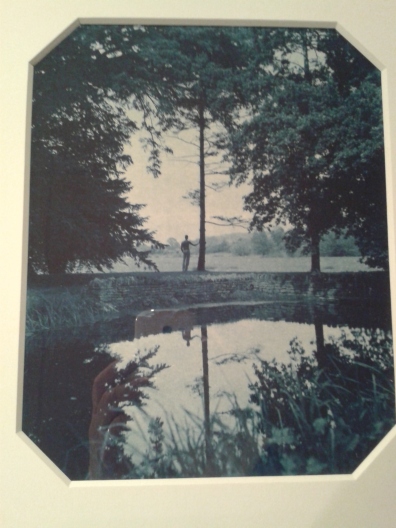
John Dugdale 1990’s

Nick Varley 2011, seaweed


Alexander Hamilton 1994
I like the indexical quality of the photograms- recording a ‘real thing’. I have developed a habit of gathering and pressing plant material for use in photograms and lumen prints.
Leeds University Print Symposium
I attended this day event in October- a very mixed bag of presentations. I get frustrated by the limitations of this model of academic information-giving-everyone sitting in rows listening to a series of speakers, with ‘time for questions’ at the end, often squeezed by poor time-keeping. What this misses is: finding out who is there in the ‘audience, why they came, what they have to offer to the information exchange; the model of questions from the audience tends to encourage the usual suspects, often men with bees in their bonnets; then they don’t stick to the question model and just bang on, dominating the proceedings. How about starting with a brief introduction exercise, maybe in twos, sharing the reasons that everyone showed up? How about sitting in a circle rather than rows? How about STRICTLY ENFORCED limits on time for presentations, followed by group discussion, self-organised as far as possible? And a closing circle where everyone shares a learning or action point from the day????? Useful principles for many kinds of social practice.
All that said there was some great stuff. I learnt about the radical history of poetry in Leeds, based around the University, Stand magazine (at 144, Otley Road), and Whitelocks. I bought a couple of Stand publications, Newcastle is Peru by Tony Harrison, and At the Stone Junction by Rodney Pybus, also about Newcastle, where some of the Stand poets moved, going on to set up Northern House and Bloodaxe Books.
There was lots of good stuff about small presses/publishers as enablers of independent thinking and dissemination of ideas. Much nostalgia about old technology like Gestetner and other hand presses. Lovely insights about the link between experience of the artisanal production methods and printed content (relevant for my interest in the non-digital, real, indexical). I have an ongoing collaborative relationship with friends who run ‘The Works’, a letterpress project in an old shed.
There were entertaining anecdotes about the people from those times, resonating back to my experience of left-wing politics and activism- the balance of head and heart, the role of emotions, and the need to control them when it seems so much is at stake.
I really liked a presentation by Luke Allen who runs a small press in Manchester producing hand-made books in a minimalist style, which he calls concrete and formal poetry, at www.sinewavepeak.com He talked of the book as an environment, a place, and is highly experimental, for example feeing his books to spend time in places associated with their content to assess the effect- the absorption of what???, something, from that time in space??
He referenced Haroldo De Campos and Paul Celan, both (coincidentally?) also referenced by Alec Finlay (whose work has lots of similarities) in his ‘poetry is still beautiful’ essay, which I blogged about on this site on April 8. Luke said that “being a person is scary, I’d rather be a place, a colour, a smell. When I’m tired I’d rather be a place, a host for work”. I love these thoughts. Have used the concept of host in my working life- a welcoming, supportive principle which helps things happen without the process being overly controlled by the organiser. I also like the idea of being a book rather than a person, and a book being a host.
Another innovator I hadn’t heard of before is Bob Cobbings, the ‘Jackson Pollock of office duplication’! Here is the header for his Wikipedia entry “Bob Cobbing was a British sound, visual, concrete and performance poet who was a central figure in the British Poetry Revival.” His devotion to self-published, small presses, experimental artists books, sound poetry, collaboration, and radical politics was inspirational, though he was obviously an awkward and quite singular person, but fun. Fantastic all round!!
I need to find out more about concrete poetry and innovative presentation for curating the gathered material on my planned walk- plants, flowers, names from gravestones (women’s names). The idea of poem-objects, like Alec Finlay’s beautifully framed handkerchiefs embroidered with text.
Someone talked about the direct degradation of language back to the poetic (echoes of Simon Armitage).
Finally there was a session about Longbarrow Press based in Sheffield. I bought one of their hand-made books, The Ascent of Kinder Scout, by Peter Riley, commemorating the famous trespass challenging restrictions of access by land-owners, and pivotal to the ongoing campaign for the ‘right to roam’. The presenter talked about book art and experiments in form linked to content- saying that ‘through craft, art becomes collective’. Lots of stuff about place, emotion, claiming significance for the provenance of all aspects of creative production. Very creative, grounded ideologically and playful. Good balance.
Rommi Smith made an important point about the whole event making a glaring omission by neglecting to include Peepal Tree Press, a nationally significant publisher of Caribbean and Black British writers based in Leeds.
Feminist research seminar
Bianca Elzenbaumer sent me information about this day event at Sheffield Hallam. It was a bit disappointing- an event mostly for PhD students to network and present. It was rather esoteric and, with one or two exceptions, not particularly relevant. It was, however, encouraging to see so many (mostly) young women happily inhabiting the feminist identity and taking space for their distinct perspectives. Issues covered included:
- Women’s specific use of the internet for solidarity and support, and sharing women’s knowledge (about knitting and craft in this example).
- An in-depth study of how women’s anxiety affects their freedom to negotiate urban space
- The use of body-mapping- inviting women to draw their bodies in relation to their experience of menstruation. This was really interesting- carried out by a young doctor in the face of her (male) colleagues’ disapproval- and producing truly beautiful and powerful images.
- There was a session about transgender issues which I found interesting but ultimately frustrating since it revisited the bitter arguments about no-platforming.
Bracha Ettinger sessions and conversation event
I have already blogged about the sessions I attended at the Tetley in the summer, at https://lesleyeleanorwood.com/2015/07/14/the-ettinger-gaze/
After discussing these events with my friends who are working with me on Women Conversation: Leeds (https://www.facebook.com/Women-Conversation-Leeds-1420746721560593/?fref=ts ), and at Bianca’s feminist reading group, I decided, with others, to set up a conversation event about Ettinger’s work. We looked at Youtube film of one of her lectures and I gave a short presentation (and hand-out) Seminar handout
The event was interesting and we decided to set up a regular converation event- Cafe Feministique, in the New Year.
Ilkley Literature Festival
I regularly attend ILF and this year there were several stand-out talks. Simon Armitage talked about his books about walking (long-distance footpaths in the Pennines and on the South-West coast). Great ideas about walking and creativity, poeisis, being in nature and meeting people on the way. Made lots of notes and drew heavily on these ideas for my dissertation.
John Thackara talked about his book ‘How to Thrive in the Next Economy’. Both he and Paul Mason (talking about his new book, Post-Capitalism) were brilliant, especially in the way their thoughts inspire a small measure of confidence in the future (as opposed to gloom and doom). Thackara runs a company called The Doors of Perception’ which shares information and supports networks on how people are living and supporting themselves sustainably around the world, often in dire poverty, but making good lives. He and Mason show how sharing can (indeed is) remaking the world sustainably and more equitably. Mason has a theory that capitalism is dying anyway and that a new human world is evolving alongside its final stages.
Work at St John’s
I contributed to the Love Arts Festival in October this year, delivering site-specific piece based on exploration of the grounds of the church. The work comprised rubbings and a paper cast of several versions of the word Sacred engraved on gravestones, and a hand-made book of cyanotype prints, photograms of pressed plant material from the graveyard. I had other ideas and took photographs of shadows. The main learning from this process, seen as a bit of action research, was the need to spend time, look, notice and respond. There was a lot of stuff-gathering and opportunities for conversation with passers-by, which could (should) have been an artwork in itself. Need to think about this for future work- sound recording, photos, interactive platforms….
Alnmouth Art Festival & Loitering with Intent
Alnmouth is a small town on the Northumberland coast- one of my significant places. It also hosts a small Art Festival each summer. I have applied to be included in the 2016 festival. It made me write an artist’s statement and the Gallery page on this site, a good exercise in making me define my work, select images and ordering them so as to present a coherent account of my practice.
Loitering with Intent is the name of another show I heard about through the Walking Artists Network. It will be at Manchester’s People’s History Museum in July, and I have applied to show my work there also. It meant that I had to do more work on the Gallery, and on the image files on my PC.
Corridor Show
I was asked to put up a show of my work in the corridor space outside the MA room at College. However intimidated I might have felt, I had to say a grateful yes to the invitation, so I am currently considering how and what to show from my work, as well as making some new, large-scale pieces. I have measured up, decided what spaces to use, and started working on the details. I am planning a conversation event to accompany the show, with specific people invited to discuss how artists can catch the ‘genius loci’, and will pull in resources from Leeds Creative Timebank to help.
Curation, curation, curation
I was advised by my tutor to research cutting-edge, contemporary curatorial practice, for the same reason, I think, that I was invited to put up the Corridor Show, that is, to learn how to present my work, which is multifarious and there’s just lots of it, in a creative way, which tells the story and conveys meaning in the way I want.
So I was keen to participate in a short course on curation led by Catriona and Kerstin, the Curation team at College. The course provided information about the history of curation and the contemporary ’scene’, supported a critical reading on current debates in the field (based on an article from the current issue of Art Monthly by Andrew Hunt), and put up an exhibition of Louise Bourgeois prints. There were great hand-outs about the practical tricks-of-the-trade and we learnt about transport and handling of work for exhibition (amazing opportunity to get close to original work by LB). We really got to know the work through time taken to consider exactly how they should be grouped and hung. I had seen the same travelling exhibition in a gallery in Hebden Bridge where the show was hung in a very boring manner. This presentation was much better and it worked well in the College’s Blenheim Walk gallery space.
We also helped with the opening evening (pic of course members and curators below) and a linked seminar on the following Saturday entitled ‘The Invisible Woman’. This gave me the idea of the conversation event to accompany the Corridor Show.
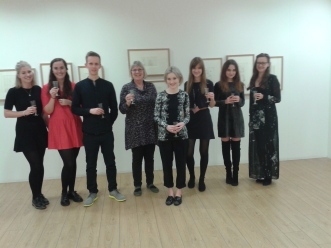
I have had my radar tuned in to the art of curation ever since. Particularly relevant during two recent visits to London (to the Other Art Fair, already commented on above) and for a ‘field trip’ I undertook in November (described below).
London field trip
I planned this to see shows and visit galleries. Went to the Ai Wei Wei exhibition at the RA. Amazing in scope, scale and the power of his political messages.

This is my picture of a girl in front of the lists of children killed by the Szechuan earthquake, on which Ai Wei Wei has campaigned for the state to be truthful about the causes and numbers of casualties. The list of children’s names filled two huge walls in the gallery.
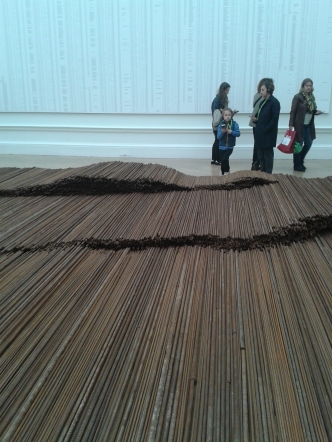
These are steel rods painstakingly reclaimed from the rubble of the quake by Ai Wei Wei, straightened and displayed on the floor.

This is more rubble restored to order- from the artist’s studio complex which was demolished as part of the developing campaign of state persecution, which culminated in his arrest and imprisonment.

Section of wall at the RA. I have asked if I could make a paper cast of this.
I also visited a brilliant exhibition of Lee Miller’s war photography. These pics are of Miller (left) and Margaret Bourke-White, both of whom were stationed in Europe as war photographers. This show was both inspiring and harrowing. Definitely a woman’s eye (I had never before seen any photographs on the issue of mass rapes of German women at the end of the war by Allied soldiers, terribly moving- one of a mother trying to cover up the exposed body of her daughter), and with the aim of reaching a female audience, especially in the images which celebrate women’s contribution to the war effort on the Home Front.
I looked up other interesting shows and found one by Cartier-Bresson on New Bond Street. It was a great show but the context was quite disturbing. New Bond Street is where London’s hyper-rich go shopping so there were many, many galleries with great work, by many eminent artists, and it was all for sale. No charge to get in (but a raised eyebrow for me in my scruff) and lots to see, all tastefully and effectively curated but it left me feeling empty!
I had a better time at an Arts Centre in West Hampstead which was hosting a show by film-maker Ben Rivers, which included a selection of work curated by him called Edgelands- an ongoing interest of mine. There were some beautiful images and the accompanying book selection in the gallery shop was full of goodies.
His commentary on the show was titled ‘The World Needs More Magicians’. I loved this show and have lots of pics and notes.
I also shopped- for women solo travel books and map-related items from Stanford’s in the West End, and for beautiful paper at Shepherd’s in Victoria, including the wonderful Khadi paper I first spotted at the Other Art Fair, available in gorgeous 30cm diameter circles, used below for developing B&W image using liquid light.
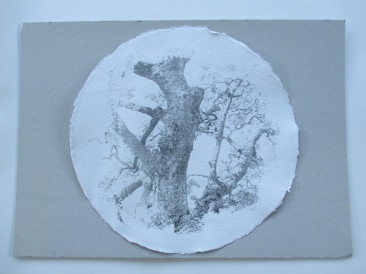
British Art Show
I have made one visit to this show and will go again. There were loads of good things but I need to return to do it justice. I have included my annotated catalogue for hand-in.
Hope Generator
This is a lovely local project mixing social practice with psychogeography and walking art I made a good contact in this group and am hoping to work more with them.
Have already blogged about the project at https://lesleyeleanorwood.com/2015/11/10/generating-hope/
Women Conversation Leeds

This bit of social practice continues at https://www.facebook.com/Women-Conversation-Leeds-1420746721560593/?fref=ts
We are thinking of a monthly conversation event- Cafe Feministique.
Trips- Scotland, Northumberland
These visits have been very useful, producing images, stories, experiences and other gathered stuff. I have blogged already about the walk I did with friends around Isaac’s Tea Trail . I’m still working with images of trees, industrial ruins and the moorland landscape from then and have some stones to use for liquid light.
Sweet Cicely, and line of trees from Northumberland, cyanotypes

Liquid light on Bible paper
I had time alone which was useful and struck up several very interesting conversations. My matriline walk will pass again through this area so I am looking forward to returning.
I gathered lots of stones from the beach at Ardmair Bay in Scotland on a visit there in April, and lots of images which I continue to use. The stones are schist and a lovely blue-grey, worn flat by the sea. I need to return to here again (for about the sixth time in the last few years).

I also have a large collection of plant material from these several locations ready to use for photograms.
Manchester
I had a fantastic weekend in the Manchester for the International Festival.

Exterior of Manchester City Art Gallery transformed into a garden.

Contemporary Chinese art exhibition at the Whitworth Gallery, Ai Wei Wei’s axe-heads on the floor. I like his display of humble objects as multiples, to restore them to significance (like the sunflower seeds).

Statue of Abraham Lincoln commemorating the support of cotton-workers in Manchester for the struggle to defeat slavery in the US.
Left Bank show: Space and Place
There was an excellent show, for one night only at Left Bank in Leeds. It was on the theme of place and here are some images:

Potternewton Hall/trees
I am developing a fascination for trees, especially bare of their leaves in winter. The project at Potternewton Hall (which I decided not to go ahead with) provided an incentive to look at the interesting collection of trees there (pictures below of a Tulip Tree and Gingko).

The images below are taken by my phone and will be used for cyanotype prints, in collections, and to make into cards and framed prints for sale and exhibition locally (they are mostly of the area where I live).
Trees and shadows

Images below are from b&w film negatives developed onto a range of substrates using liquid light.


The research in this case is going out and taking photographs, taking account of composition, light conditions and conceptual content. Alongside this I have been consulting reference books to identify and know more about tree species.
I particularly like the monochrome character of bare trees and the grace of their overall form, together with the delicately patterned tracery of their branches. I like to catch them in silhouette on the horizon with only sky behind- cloud formation and good light add interest.
















